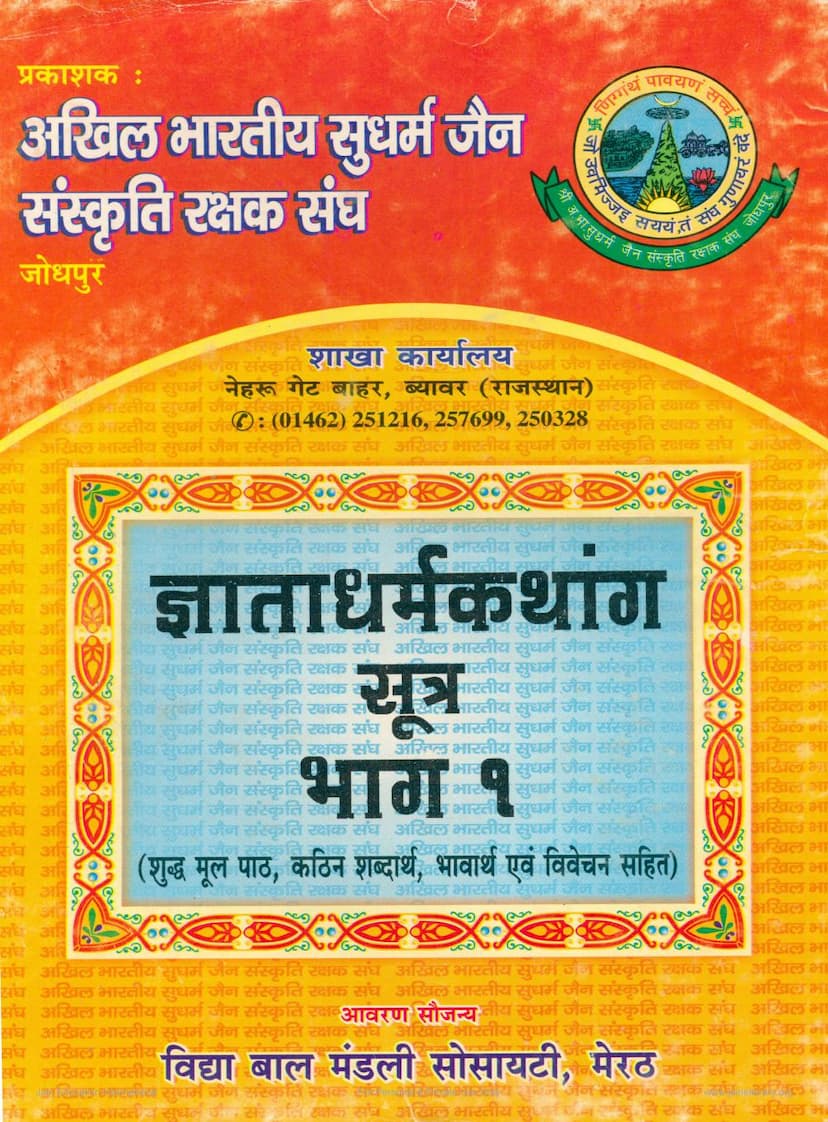Gnata Dharmkathanga Sutra Part 01
Added to library: September 1, 2025

Summary
Here's a comprehensive summary of the provided sections of the Gnata Dharma Kathanga Sutra, Part 01:
Book Title: Gnata Dharma Kathanga Sutra Part 01 Authors: Nemichand Banthiya, Parasmal Chandaliya Publisher: Akhil Bharatiya Sudharm Jain Sanskruti Rakshak Sangh
Overall Purpose:
The Gnata Dharma Kathanga Sutra is part of the Jain Agam literature. This particular volume, Part 01, focuses on the initial studies (Adhyayan 1 to 8) and is presented with original text, difficult word meanings, commentary, and analysis. It falls under the category of Dharma Katha Anuyoga (Discourse on Religious Narratives) within Jain philosophy, meaning its primary purpose is to convey religious teachings through stories and narratives. The sutra aims to illustrate Jain principles and practices through the lives of individuals and events, highlighting the consequences of actions (karma) and the path to spiritual liberation.
Key Themes and Concepts Introduced in the Summary:
- Authenticity of Jain Agam Literature: The introduction emphasizes the authenticity of Jain Agam literature, stating that it originates from the teachings of the Tirthankaras, who are considered omniscient and free from attachment and aversion. This is contrasted with other philosophical literature which is claimed to be a compilation of ideas from various sages, potentially leading to inconsistencies.
- Classification of Agam Literature: The summary explains that Agam literature is classified in various ways, including:
- Anga-pavishta (Part of the Angas) and Anga-bahya (Outside the Angas): Based on whether the text is part of the core twelve Angas or external to them.
- Various Classifications by Acharyas: Anga, Upanga, Moola, Chheda, and Avasyak Sutras.
- Subject Matter Classification: Dravyanuyoga (Metaphysics), Ganitanuyoga (Mathematics/Cosmology), Dharmakathaanuyoga (Religious Narratives), and Charan Karananuyoga (Conduct and Discipline).
- The Gnata Dharma Kathanga Sutra's Place: It is identified as the sixth Anga of the Dwadashangi (the twelve principal Angas) and falls under Dharmakathaanuyoga due to its narrative nature.
- Content of the Gnata Dharma Kathanga: The sutra is described as containing narratives of various individuals, including kings, ascetics, and householders. It details their actions, penances, renunciation, journeys to celestial realms, rebirths, and eventual attainment of enlightenment or suffering based on their karma.
- Purpose of the Narratives: The stories serve to illustrate:
- The suffering caused by attachment to worldly pleasures and the negative consequences of actions stemming from passions (kashayas) and uncontrolled senses.
- The immense benefits of righteous conduct, self-control, penance, and right faith (samyak darshan), leading to auspicious rebirths and eventual liberation.
- The importance of understanding the subtle principles of Jain philosophy through relatable examples.
- Structure of the Gnata Dharma Kathanga: It is stated to have two Shrutaskandhas (sections of scriptures):
- First Shrutaskandha: Nata Adhyayanas (Known Studies): Contains nineteen studies (adhyanas). Of these, ten are primarily illustrative (known examples). The remaining nine studies are extensive, each containing numerous aakhyayikas (stories within stories) and upaakhyayikas (sub-stories). The sheer number of these narratives is described as immense (billions), emphasizing the vast scope of teachings.
- Second Shrutaskandha: Dharma Kathas (Religious Narratives): Contains ten "classes" or groups of stories related to dharma.
- Specific Narratives Highlighted (from the provided summary):
- Study 1: Meghkumar: Illustrates the importance of enduring hardship in ascetic life. Meghkumar, a prince, initially faltered on his first night of renunciation due to minor discomforts but was reminded of his severe past hardships in previous lives (through jati smaran gnan - recollection of past lives), leading to his steadfastness. It also teaches about anatma-bhava (non-self-consciousness) and atma-bhava (self-consciousness) in dealing with difficulties.
- Study 2: Dhanya Sarthavaha: Focuses on the practical aspects of asceticism, particularly regarding food. It highlights the need for detachment from the body and the purpose of nourishment for spiritual practice, using the example of Dhanya and his wife Bhadra, and their son’s kidnapping. It also touches upon the concept of duty and religious understanding in giving alms.
- Study 3: Egg (Andak): Emphasizes the importance of faith and the detrimental effects of doubt and skepticism in spiritual practice, contrasting the fate of a shell-ridden egg (doubtful) with a nurtured egg (faith).
- Study 4: Tortoise (Kurma): Stresses the necessity of controlling the senses for spiritual progress, using the analogy of a tortoise withdrawing its limbs for safety versus one that exposes them to danger.
- Study 5: Shellaka: Illustrates the concept of recommitment to the spiritual path and the reawakening of dormant spiritual fervor, using the example of King Shellaka who became complacent in his asceticism but was awakened by a disciple's devotion and the timely reminder of religious duties (like pratikraman).
- Study 6: Tumba: Explains the concept of spiritual progress and downfall through the analogy of a gourd coated with mud. As layers of karma are shed, the soul ascends; when karma accumulates, the soul descends.
- Study 7: Malli: Illustrates the qualities and consequences of observing the five great vows (mahapratas) through the example of Dhanya Sarthavaha's daughters-in-law. Different levels of observance lead to different outcomes.
- Study 8: Malli: Presents the story of Lord Mallinath, the 19th Tirthankara, highlighting that karma affects everyone regardless of status. It also includes the tale of the devout layman Arhanta, demonstrating the power of strong devotion.
- Detailed Descriptions: The summary provides vivid descriptions of ancient Indian life, including city planning, architecture, royal customs, rituals, festivals, and even the psychological states of characters.
- Translations and Editors: The summary mentions the translators and editors, including Prof. Dr. Chhaganlal Shastri and Mahendrakumar Rankawat, highlighting the effort to make the text accessible with original text, meanings, and commentary.
In essence, the Gnata Dharma Kathanga Sutra, Part 01, serves as a didactic text that uses engaging stories to teach fundamental Jain ethical and philosophical principles, illustrating the law of karma and the path to spiritual advancement.